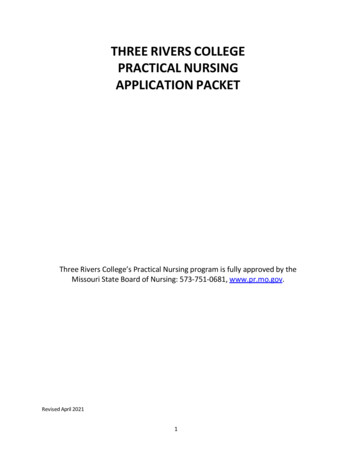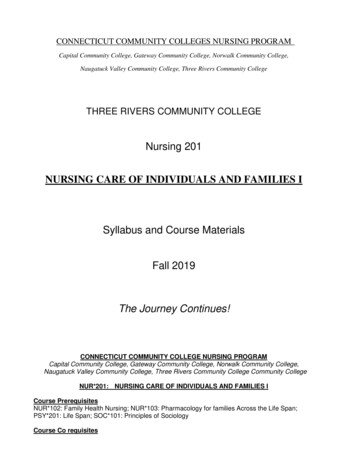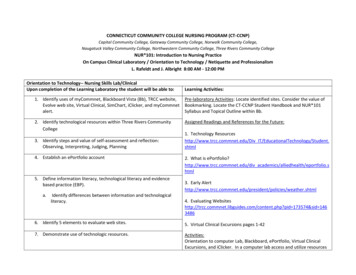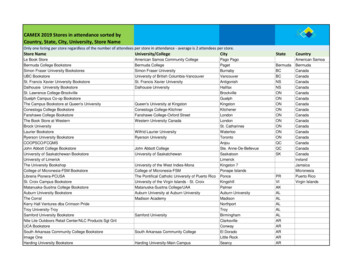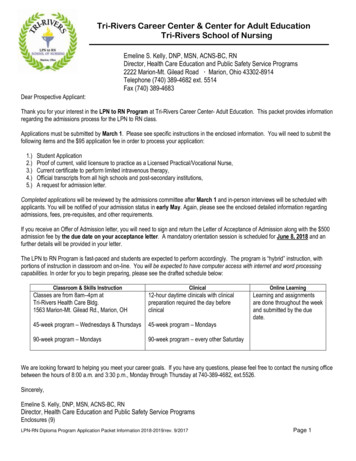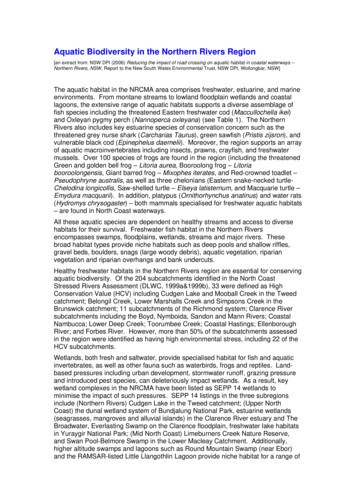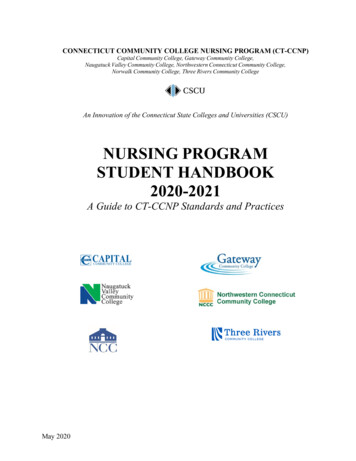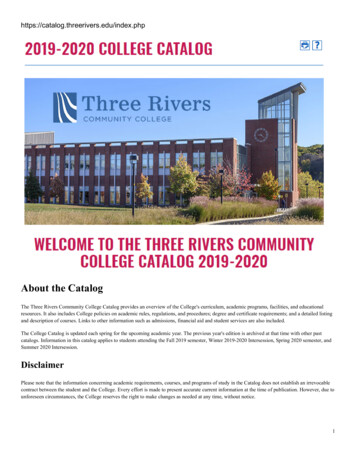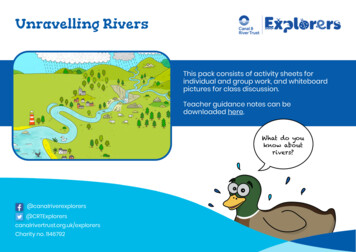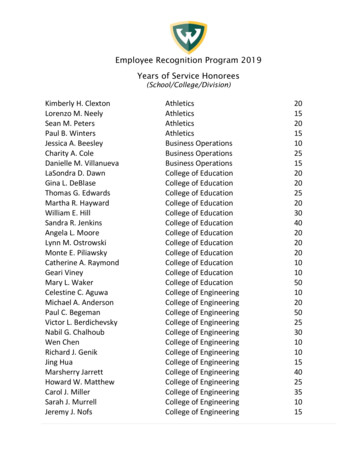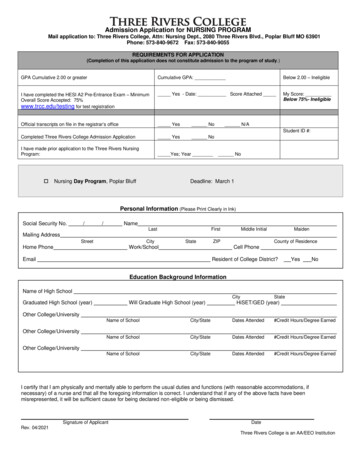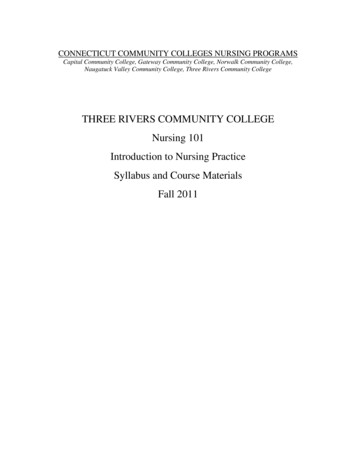
Transcription
CONNECTICUT COMMUNITY COLLEGES NURSING PROGRAMSCapital Community College, Gateway Community College, Norwalk Community College,Naugatuck Valley Community College, Three Rivers Community CollegeTHREE RIVERS COMMUNITY COLLEGENursing 101Introduction to Nursing PracticeSyllabus and Course MaterialsFall 2011
CONNECTICUT COMMUNITY COLLEGE NURSING PROGRAMCapital Community College, Gateway Community College, Norwalk Community College,Naugatuck Valley Community College, Three Rivers Community CollegeNUR*101: INTRODUCTION TO NURSING PRACTICECourse PrerequisitesBIO 211: Anatomy & Physiology I; BIO 212: Anatomy & Physiology II; ENG 101: EnglishCompositionCourse CorequisitesBIO 235: Microbiology; PSY 111: General PsychologyCourse ComponentsCredits8 creditsHoursClassroom: 60 hoursClinical: 180 hoursCourse DescriptionThe student will focus on concepts basic to nursing practice. Emphasis is placed on applicationof the nursing process, communication, and skill acquisition. Clinical and laboratoryexperiences offer opportunities to integrate theoretical principles and demonstrate caring andcompetence in beginning professional role development.Course ObjectivesAt the completion of this course, the student will be able to:1. Identify principles of holism in providing basic nursing care to selected individuals.2. Utilize the nursing process in planning care for individuals with basic health care needs.3. Demonstrate safe use of scientific and quantitative principles and technology in providingbasic nursing care to individuals.4. Use basic communication in nurse-client interactions.5. Identify learning needs for assigned individuals.6. Utilize therapeutic interventions that consider the unique rights of individuals.7. Identify the roles of various members of the health care team.8. Demonstrate basic legal and ethical practice standards when providing care to selectedindividuals.9. Exhibit growth in personal and professional roles in nursing.
Course ScheduleLecture: Monday 8:30-10:30 AM and 1:00-3:00 PM Room A220.Classroom Laboratory:Tuesday and Thursday: 8:00 AM-3:00 PM Weeks 1 – 7, Room A220/A118Clinical: Weeks 8 – 15 as assignedNursing Faculty and StaffDirector of Nursing and Allied Health: Ellen Freeman, M.S., CNE, RN, ProfessorOffice: D109Phone & Voicemail: 383-5273E-mail: efreeman@trcc.commnet.eduEducational Assistant to the Director:Linda Violette-Buisson: 885-2661, D109, eJudith Albright, M.S.N, RN, CWOCN, Associate Professorjalbright@trcc.commnet.eduOffice: C262 Faculty OfficesPhone & Voicemail: 383-5285Lillian Rafeldt, M.A., R.N, CNE, Professorlrafeldt@trcc.commnet.eduOffice: C230 Faculty OfficesPhone & Voicemail: 383-5257Nancy Rymut M.S., R.N. C.E.N, Professornrymut@trcc.commnet.eduOffice: C236 Faculty OfficesPhone & Voicemail: 892-5718Course LeaderFull Time Faculty: Special Lecturer and ELL /Culture Facilitator:Judith Snayd, M.S., R.N, CNE, Professorjsnayd@trcc.commnet.eduOffice: C242 Faculty OfficesPhone & Voicemail: 383-5726
Part-TimeJill Blain, M.S.N., R.N., adjunct clinical facultyMartha Healy, M.Ed., R.N., adjunct clinical facultySusan Rosa, M.S.N., R.N., adjunct clinical facultyPatricia Zikorus, M.S.N., R.N., adjunct clinical facultyNursing Lab Staff:Sue Turner, M.S.N., R.N., Nursing Lab CoordinatorOffice Phone: 383-5236E-mail: sturner@trcc.commnet.eduMethods of InstructionThis course is team taught. Teaching modalities include lecture, discussion, case studies,demonstration, return demonstration, guest speakers, experiential exercises, small groupactivities, and clinical practice. Computerized programmed instruction and interactive video andsimulations are also used. Blackboard Vista and ePortfolio are used as learning managementtools.Required Textbooks: All textbooks are used in subsequent coursesNeeded at beginning of course:Bundle (six books) available through TRCC Bookstore:Lewis S. et al. (2011). Medical Surgical Nursing: Assessment and Management ofClinical Problems (8th ed.). St. Louis, MI: Mosby/Elsevier.978-0-3230-6581-8Potter, P & Perry, A. (2011). Fundamentals of Nursing Enhanced Multimedia Edition(7th ed.) St. Louis MI: Mosby/Elsevier.978-0-3230-8083-5Potter, P & Perry, A. (2011). Virtual Clinical Excursions for Fundamental of Nursing7th Edition. St. Louis, MI: Mosby/Elsevier.978-0-3230-5522-2Perry, A. and Potter, P. (2011). Clinical Nursing Skills and Techniques (7th ed.). St.Louis, MI: Mosby/Elsevier.978-0-3230-5289-4Lehne, R.A. (2010). Pharmacology for Nursing Care (7th ed.). St. Louis, MI:Saunders/Elsevier.978-1-4160-6249-3
Varcarolis, E.M., Carson, V.B., & Shoemaker, M.C. (2009). Foundations ofPsychiatric Mental Health Nursing: A Clinical Approach (6th ed.). St. Louis, MI:Saunders/Elsevier.978-1-4160-6667-5Please note: ISBN number is for single copy text only, not for the bundle. Bundlesaves money. Bundle has a separate ISBN number and is available through TRCCbookstore only. Bundle ISBN is 9781437734225Pickar, G.D., & Abernethy, A.B. (2008). Dosage Calculations (8th ed.). Clifton Park, NY:Thomson/Delmar.978-1-4180-9047-1Needed for Pharmacology lectures and medication labsLehne, R.A. (2010). Pharmacology for Nursing Care (7th ed.). St. Louis, MI: Saunders/Elsevier.978-1-4160-6249-3Deglin, J.H., Vallerand, A.H. & Sanoski, C.A. (2011). Davis’s Drug Guide for Nurses (12th ed.).Philadelphia, PA: F.A. Davis.976-0-8036-2310-1Needed for Nursing Process lecture and labsAckley, B.J., & Ladwig, G.B. (2010). Nursing Diagnosis Handbook: An Evidence-Based Guideto Planning Care (9th ed.). St. Louis, MI: Saunders/Elsevier.978-0-323-07150-5Needed for beginning of clinical experiencePagana, K.D., & Pagana, T.J. (2009). Mosby’s Manual of Diagnostic and Laboratory Tests (4thed.). St. Louis, MI: Mosby/Elsevier.978-0-323-05747-9Optional Textbooks:Tucker. S. (2011). Nutrition and Diet Therapy for Nurses. Upper Saddle, New Jersey:Pearson/Prentice Hall.9780131722163Sommers, M.S., & Johnson, S.A. (2011). Diseases and Disorders: A Nursing TherapeuticsManual (4th ed.). Philadelphia, PA: F.A. Davis.978-0-8036-2205-0
Purnell, L.D., & Paulanka, B.J. (2009). Guide to Culturally Competent Health Care (2rd ed.).Philadelphia, PA: F.A. Davis.978-0-8036-2205-0Wilkinson, J.M. (2007). Nursing Process and Critical Thinking (4th ed.). Upper Saddle, NewJersey: Pearson/Prentice Hall.9780132242868Consider:Mosby’s Dictionary of Medicine, Nursing, and Health Professions, 8th ed, 2009Faculty / Staff AvailabilityStudents are encouraged to seek clarification with the course leader as needed. Students are alsoencouraged to seek advisement with faculty as needed. Scheduled faculty office hours areposted outside faculty offices. Students may also meet with faculty by appointment.Study GroupsStudents are encouraged to form study groups which can meet in the lab or at another mutuallyconvenient location. Tutors within the nursing lab are available during posted hours of theNursing Laboratory. Students are encouraged to be proactive in their learning and seek helpindependently. The Helene Fuld Nursing Lab and Nursing Tutors are in place to promotesuccess and retention. Students are encouraged to utilize these learning opportunities weekly.Practice materials are available in the course website on Blackboard, text book web sites andCDs / DVDs, material within the nursing laboratory and the Learning Resource Center (LRC).Sample exam questions can be found within these materials. Students may use the following inthe Nursing Laboratory to improve test taking skills.Nugent, P. A., & Vitale, B. A. (2008). Test Success, Test-Taking Techniques for BeginningNursing Students (5th ed.). Philadelphia: F.A. Davis.Nursing Program College FacilitiesFaculty offices are located within C wing.The Nursing laboratory is located in A118.Computer labs are located in the nursing lab A212 and throughout the campus (library and Ewing.The Learning Resource Center is located in the C wing, ground floor.
Class ExaminationsExam1Exam 2Exam 3Exam 4Exam 5Final 15%15%25%Dosage Calculation Competency: Thursday, 9/29/11Pass/Fail (Must achieve a 90 to pass)Grading PoliciesTo pass Nursing 101 and progress in the nursing program a student must achieve ALL of thefollowing: Earn at least a 74 average in the theoretical portion of the course. Test items aredrawn from ALL content of the course; theory, lab, clinical and math. Pass the clinical component of the course in a satisfactory manner. Pass Dosage Calculation Competency with 90% accuracy. Students may use calculatorsprovided by the college for all exams involving drug calculations. A student may notadminister medications until s/he has successfully passed the dosage calculationexamination. A student will be given three (3) attempts to pass the dosage calculationexamination. A student who fails the dosage calculation examination must participate inremediation before taking the next examination. A student who fails the third (3rd)examination will be withdrawn from the nursing course and dismissed from the nursingprogram. Pass required clinical skills validations. Three (3) opportunities will be given to passthe skills validation. Students unable to meet critical criteria the second attempt willmust attend mandatory remediation. Evaluation activities: Clinical: A conference will be scheduled by the learner with his/her clinicalinstructor for discussion and evaluation of the student's progress at the end of eachclinical week. The Formative Clinical Evaluation Form will be completed by theinstructor and reviewed and signed by the student at each weekly meeting. Clinicalperformance is evaluated according to the objectives identified on the evaluationform. Students must successfully meet the clinical objectives in order to pass thecourse. Students are responsible for self-evaluation and documentation. A summativeevaluation will be completed, reviewed, and signed at the end of the semester. Theory: There will be five 50 minute exams (30-50 questions each) and one twohour final examination (100 questions). The exams will start at 8:30AM. Class willresume at 9:30 a.m.
-Weight: Each exam is worth 15% of the theory grade for 75% of total grade. Finalexamination 25% of total grade. The five exams plus the final the letter grade inthe course.In order to pass the course students are required to receive a satisfactory clinicalevaluation, pass the math test as previously stated, and pass required clinical skillsvalidations.Grading Scale:A 93-100 AB 87-89 BC 77-79 CD 67-69 DF 60-6390-9283-8674-7664-66B- 80-82C- 70-73Nursing Program Policy HandbookRefer to the Nursing Program Policy Handbook for detailed information regarding: Missed Exams Clinical Evaluations College Labs Attendance Required Clinical Equipment Professional Appearance in the Clinical Sites Return if withdraw Inability to return under certain circumstancesAttendance PolicyStudents are expected to attend each lecture, classroom laboratory and clinical experience. It isthe student's responsibility to notify the instructor if absence is necessary and to fulfill objectivesof the experience. All clinical absences are to be made up as per the Nursing Program PolicyHandbook. (Uniform is required for both college laboratory clinical experiences and clinicalexperiences at health care agencies. See Nursing Program Policy Handbook for uniformrequirements.)Test Make-Up PolicyIf you must be absent from a scheduled test due to personal illness or other emergency, contactthe course coordinator by 8 a.m. on the morning of the test. Failure to do so may result in afailing grade for that test. Any absent student taking a make-up examination will have 15 pointssubtracted from the examination grade unless documentation of extenuating circumstances hasbeen provided and approved.Students with an approved absence from scheduled tests will be given an alternate examination.The make-up will be cumulative and determined by the course leader and full time faculty at theend of the semester.Statement on Penalty for Academic Dishonesty or PlagiarismPlagiarism is the unacknowledged use of another person’s words or ideas in your writing.Whether conscious or not, plagiarism is a serious offense. Evidence that you did not write
material that you submit under your name can result in failure for the entire course. Refer to2011-2012 College Catalog for policy. Students are expected to: “Demonstrate academicintegrity by not engaging in conduct that has as its intent or effect the false representation of astudent’s academic performance, including but not limited to: (a) cheating on an examination; (b)collaborating with others in work to be presented, contrary to the stated rules of the course; (c)plagiarizing, including the submission of others’ ideas or papers (whether purchased, borrowedor otherwise obtained) as one’s own; (d) stealing or having unauthorized access to examinationor course materials; (e) falsifying records or laboratory or other data; (f) submitting, if contraryto the rules of a course, work previously presented in another course; and (g) knowingly assistinganother student in any of the above, including an arrangement whereby any work, classroomperformance, examination, or other activity is submitted or performed by a person other than thestudent under whose name the work is submitted or performed.” Consequences are delineated inthe College Catalog.Additional Expected Activity RequirementsStudents are expected to participate in class discussions, role-play, material review and labpractice. Participation enhances the learning experience and allows students and instructors theopportunity to learn from each other. Students will be expected to submit work (Course, ProcessRecording, Definition of Nursing, and Information Literacy Assignment) to ePortfolio.Students are reminded that classroom demeanor is a vital part of participation. Students shouldbehave appropriately at all times and are asked to practice common courtesy, recognizing eachperson's right to learn in an atmosphere conducive to the learning experience. Students whoviolate the rules of courtesy and/or professional demeanor will be asked to leave. Students arerequired to attend all classes. Tardiness and early leaves as well as absences have a direct impacton student learning.WITHDRAWAL POLICY:Students may withdraw, in writing, at the Registrar's Office for any reason. Refer to the Nursingand College Student Handbooks and College Catalog. Students who receive an overallunsatisfactory clinical grade at any time in the rotation will fail the course and receive a grade ofF. Students who receive a clinical grade of Fail should consult the Student Handbook for CTCCNP policies. Students with concerns about their course average are encouraged to contact thecourse leader.DISABILITIES STATEMENT:If you have a hidden or visible disability which may require classroom or test-takingmodifications, please see the course leader as soon as possible. If you have not already done so,please be sure to register with Chris Scarborough if you have a learning disability, ADD orADHD, or Student Services for other physical disabilities. Please see the Three RiversCommunity College Catalog for additional policies and information.CLINICAL CANCELLATION DUE TO INCLEMENT WEATHER:When the college is closed for reasons of inclement weather, clinical experiences will also becanceled. When the college delays opening, clinical experiences will begin one hour later.However, students should use discretion in traveling in poor weather conditions. If you areunable to report to scheduled clinical experiences, be sure to notify your clinicalinstructor. Preplanning and communication with your clinical instructor and course leader is
important. The College Student Handbook and Catalog lists radio stations announcingcancellations. There also will be a notice of delays or cancellation on a recording at 886-0177.Postings may also be seen on the Three Rivers Web Page: www.trcc.commnet.edu or viaBlackboard.UNIT OBJECTIVESContemporary Nursing Practice1. Discuss various definition of nursing2. Explain the use of critical thinking related to the nursing process.3. Discuss historical leaders in nursing4. Discuss educational preparation for professional nursing5. Discuss the role that caring plays in building a nurse client relationship6. Discuss contemporary roles of the registered nurse7. Describe the philosophy of the nursing program.8. Identify the core values of the nursing programCore Values: Holism, Caring and Cultural Diversity in Nursing1. Discuss the relationships between health, wellness, illness, and disease2. Explain the concept of health promotion3. Discuss the concept of holism as it relates to nursing practice4. Describe the variables influencing health beliefs and health practices5. Describe health promotion for the individual and the community6. Discuss the concept of caring7. Describe client’s perceptions of caring behaviors in a nurse8. Describe how nurses demonstrate caring behaviors in practice9. Discuss the nursing process and critical thinking as they relate to caring10. Discuss demographic trends on health and nursing11. Discuss health disparities as they relate to culture and ethnic diversity12. Describe the core competencies of culturally sensitive nursing care13. Use cultural assessment to plan culturally competent careHealth Protection and Safety1. Utilize the chain of infection to discuss client risk factors2. Describe assessment data with inflammatory response vs. infectious response3. Discuss interventions to prevent the transmission of pathogens4. Compare medical and surgical asepsis5. Demonstrate use of personal protective equipment in contact, droplet, and airborneisolation6. Discuss rationale for standard precautions7. Demonstrate correct technique for hand hygiene8. Demonstrate correct application and removal of clean gloves9. Identify the role of the Center for Disease Control in infection management andenvironmental safety10. Discuss the nurse’s role in early identification of data that might suggest epidemic orbioterrorism activity
11. Discuss risks to safety based on developmental stage, lifestyle, and pathophysiology12. Discuss interventions to reduce physical hazards in the health care, home, andcommunity environmentsVital signs1. Define vital signs2. Discuss risk factors, incidence, prevalence and significance of hypertension of hypertension3. Discuss the impact of hypertension on wellness4. Discuss the importance of early recognition and treatment of hypertension to wellness/healthmaintenance5. Discuss the basic goals of the treatment(s) for early stage hypertension6. Describe factors that affect vital signs and accurate measurement of them7. Identify peripheral pulse sites8. Identify variations in vital signs according to age9. Measure vital signs in an organized, accurate mannerBlood Glucose and Glycemic Control1. Differentiate between Type I and Type II diabetes2. Identify the diagnostic and clinical significance of blood glucose monitoring3. Discuss appropriate equipment for blood glucose monitoring4. Compare insulin types and schedules for diabetes management5. Identify the role of oral hypoglycemic agents in diabetic therapy6. State the symptoms of hypoglycemia and hyperglycemiaCardiopulmonary Function1. Explain factors that alter respiratory and cardiac function2. Describe assessment findings in clients with altered cardio-pulmonary function3. List appropriate nursing diagnoses for the client with cardiopulmonary dysfunction4. List nursing intervention that support respiratory and cardiac function5. Evaluate outcomes that define client progress in the promotion of cardiac and respiratoryfunctionSkin Integrity and Wound Care1. Discuss the physiologic process of normal wound healing2. Discuss complication of normal wound healing3. Identify risk factors that contribute to pressure ulcer formation4. Discuss staging criteria for pressure ulcers5. Describe wound assessment criteria6. List nursing diagnoses associated with impaired skin integrity7. Discuss interventions for wound management including mechanism of action of woundcare dressings8. Describe evaluation criteria for a client with impaired skin integrityCritical Thinking and the Nursing Process1. Discuss the use of critical thinking in clinical practice2. Describe the relationship of critical thinking and problem solving to the nursing process3. Describe the components of the nursing process
4. Identify the components of the assessment phase of the nursing process5. Differentiate between subjective and objective data6. Describe methods of data collection7. Describe the purposes of physical assessment8. Identify techniques used for physical assessment9. Identify expected outcomes of physical assessment10. Discuss variations in techniques and findings of physical assessment based on age11. Compare frameworks for data organization12. Discuss the process of data analysis and selection of a nursing diagnosisDocumentation and Reporting1. Discuss the purpose of a health care record2. Compare and contrast different documentation methods3. Discuss documentation needs of various health care settings4. Discuss legal aspects of documentation5. Relate the nursing process to documentation on the client record6. Describe the guidelines for effective reportingTherapeutic and Professional Communication1. Identify the elements of effective communication2. Identify the different forms of communication3. Explain the nursing focus in each of the four phases communication4.5.6.7.Describe the importance of effective communication in the delivery of nursing careIdentify behaviors and techniques that impact client/nursecommunicationDemonstrate communication techniques for healthcare professionals that enhance andpromote client/nurse relationships and the delivery of holistic care8. Describe effective communication between healthcare professionals9. Identify nursing outcomes of effective and therapeutic communication10. Identify barriers to therapeutic communication11. Discuss the application of therapeutic communication techniques in each phase of thenursing process.12. Apply the nursing process to clients with specific barriers to effective communicationStress and Coping1. Discuss the concept of physiologic adaptation to stress.2. Discuss models of stress used to predict individual responses3. Compare the effects of short-term stress vs. long-term stress4. Describe the physiologic and psychological responses to stressNutrition1. Describe the role of the diet in promoting health.2. Identify the components of the recommended dietary allowances (RDA), basic four foodgroups and exchange lists.3. Describe the functions of proteins in health and in illness.4. Describe risks associated to Lipids.
5. Discuss energy balance.6. Discuss alternative therapies as they relate to nutrition.7. Discuss ways in which information on food labels may help in food selection.8. Discuss body weight and body mass standards.9. Discuss essential components and purposes of nutritional assessment.10. Identify risk factors for and clinical signs of malnutrition.11. Identify factors influencing nutrition.12. Describe nursing interventions to promote optimal nutrition13. Discuss nursing interventions to treat clients with nutritional problemsSafe and Competent Practice Medication Administration1. Define selected terms related to the administration of medications.2. Describe the legal aspects of administering medications.3. Describe various routes of medication administration.4. Identify factors affecting medications actions.5. Review systems of measure in medication administration.6. State rights of medication administration.7. Identify implications associated with drug therapy in the older adult.8. Review various medication administration routes.9. Describe sites used for subcutaneous and intramuscular injections.10. Review documentation of medication administration11. Identify parts of a medication orderSleep, Comfort and Pain1. Describe variations in sleep patterns across the lifespan2. Explain factors that affect sleep3. Describe common sleep disorders4. Discuss interventions to promote sleep5. Describe developmental and cultural factors that affect the pain experience6. Discuss guidelines for selecting and individualizing pain therapies7. Discuss use of non-pharmacological pain therapies8. Discuss pharmacologic interventions for pain9. Compare and contrast barriers to pain relief as they relate to nurses and clients10. Differentiate tolerance, dependence, and addictionActivity and Exercise1. Discuss the benefits of exercise on physiologic and psychological functioning2. Demonstrate the principles of body mechanics3. Describe/demonstrate active and passive range of motion exercises4. Describe/demonstrate safe practices when positioning, moving, lifting, and ambulatingclients5. Discuss the causes and hazards of immobility on body systems6. List nursing interventions for an immobilized clientFluid and Electrolyte Balance1. Identify factors that influence normal body fluid and electrolyte balance. Collectassessment data of fluid and electrolyte balance
2. Identify nursing diagnosis and actions to care for the client with fluid and electrolyteimbalances.3. Describe acid base balance and the role of the buffer systems.4. Identify nursing diagnosis and actions to care for the patient with an acid base imbalanceUrinary Elimination1. List developmental, life-style, and other factors that influence the care of clients withurinary elimination dysfunction.2. Describe and perform focused assessment of urinary elimination.3. Identify nursing diagnoses that correctly define client problems related to elimination.4. Review and practice common nursing and collaborative interventions to promoteadequate urinary eliminationBowel Elimination1. Describe factors which influence bowel elimination.2. Describe normal and abnormal characteristics of feces.3. Identify common causes and effects of selected bowel elimination problems.4. Identify interventions which maintain normal bowel elimination.5. Develop nursing diagnosis and care of the patient with altered bowel elimination.Discharge Planning1. Describe the process of assisting the patient in Discharge Planning.2. Identify the nurse’s role in preparing the client for discharge.3. Describe the coordination between different agencies a client may use after hospitaldischarge.Communication, Teaching and Learning1. Identify the role of the nursing client teaching.2. Describe the domains of learning.3. Identify basic learning principles.4. Identify factors that affect5. Identify ways to assess the learning needs of the client.6. Describe an environment that promotes learning.7. Identify methods to evaluate learning.8. Develop nursing diagnosis & plan of care reflecting the learning needs of a client.9. Discuss teaching strategies to assist clients of various culturesSensory Perception1. Describe factors influencing sensory function.2. Identify clinical symptoms of sensory overload or deprivation3. Describe the components when assessing a client’s sensory function.4. Develop a nursing plan of care for the client with impaired sensory function.Legal and Ethical Principals1. Compare the concepts of ethics, moral and values.2. Identify ethical principles.3. Discuss various legal regulations that influence nursing practice.
4. Describe the legal considerations regarding: confidentiality, documentation, medicalrecords.5. Describe the legal controls governing the practice of nursing.Introduction of Mental Illness and Defense Mechanisms1. Describe the differences between mental health and mental illness.2. Discuss how culture influences attitudes toward mental health and illness3. Describe the DSM-IV-TR evaluation system for classification of mental disorders.4. Discuss the ethical issues relevant to psychiatric nursing.5. Discuss legal issues relevant to psychiatric nursing.6. Discuss common defense mechanisms used and state the purpose of each.7. Review the history of nursing practice related to the mentally ill patientTherapeutic Communication1. Discuss therapeutic feedback.2. Review the process of therapeutic communication.3. Distinguish factors that influence communication.4. Identify factors that contribute to effective communication.5. Discuss the assessment of nonverbal communication.6. Describe the phases of therapeutic communication.7. Compare and contrast social vs. therapeutic interactions.8. Describe therapeutic communication techniques.9. Describe active listeningSpirituality1. Define concepts of spirituality as it relates to nursing care.2. Identify characteristics of spiritual health. Identify factors associated with spiritualdistress and manifestations.3. Describe spiritual development across the lifespan.4. Assess the spiritual needs of the patient and plan care.5. Review interventions to support the clients’ spiritual beliefs6. Identify desired outcomes for evaluating the clients’ spiritual health.Sexuality1. Define sexual health.2. Identify specific measures that promote sexual health.3. Identify personal biases and beliefs related to sexuality.4. Discuss the role of the nurse in sexual health promotion and health screening.5. Utilize the nursing process in caring for clients with reproductive and sexuality issuesRev 7/11 NR
2. Utilize the nursing process in planning care for individuals with basic health care needs. 3. Demonstrate safe use of scientific and quantitative principles and technology in providing basic nursing care to individuals. 4. Use basic communication in nurse-client interactions. 5. Identify learning needs for assigned individuals. 6.
